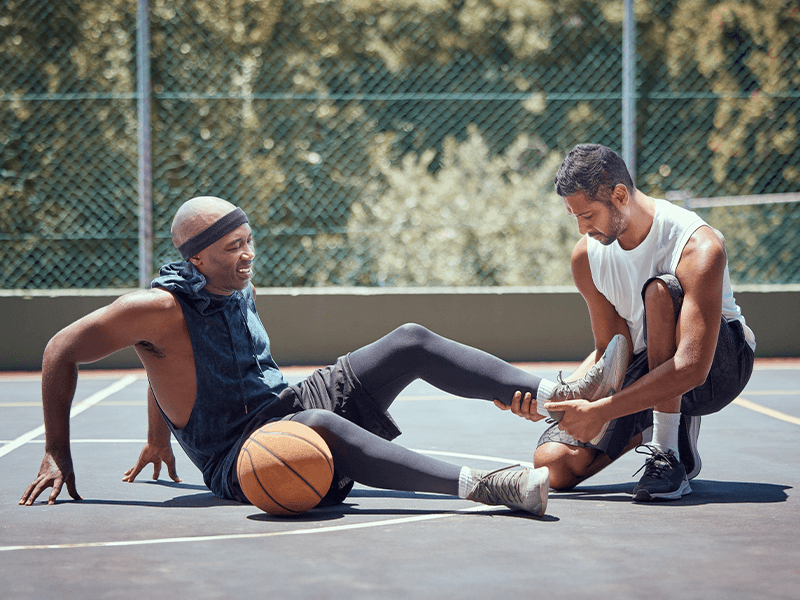Search
Find a Physician
Robert A. DeFalco, Jr., DO
Medically Reviewed by
William Sayde, MDBlog
Sep 21, 2024
When talking about dangerous occupations, most people will immediately think about something like construction, or mining, but, what if we told you that roughly 40% of athletes get injured every year?
Sure, not all of these injuries are severe (which is why the figure is often disputed), but the statistic is still alarming.
Now, before we start discussing how to prevent sports injuries, let’s first address why this happens.
When you think about it, you have an unusually large group of driven people who are pushing their bodies to the limit on a daily basis. They are conditioned to ignore pain and fatigue, which is the complete opposite of what any doctor would advise you to do.
They facilitate their recovery (which is not the same as a conventional recovery), take supplements and performance enhancers (that allow them to push their bodies further than it was meant to go), and they do it continuously for years and decades.
With all of this in mind, that 40% figure might start seeming quite low.
Well, this is because the majority of these athletes (and their coaches) also know how to prevent sports injuries (for the most part). Here are some methods they use!
Sports injuries is a pretty common term, which is why it might be a good idea to split the answer into two categories:
Here’s what you should know about it.
Some injuries happen so often that it’s really hard to find a person who is physically active and hasn’t experienced them several times over their lifetime.
The type of injury that you’re most exposed to is usually matched to the sport or activity you practice the most. A concussion is not as likely in running as it is in boxing or hockey.
Not all injuries are as bad, and while a shin splint can be severe, it’s probably not as bad as a spinal cord injury, a severe concussion, a broken neck, or an Achilles tendon rupture. With that in mind, here are some of the worst sports injuries that you can encounter.
Keep in mind that the reason these severe injuries are less common is mostly because there are rules and equipment designed to prevent them. Unfortunately, no method of protection is 100% reliable.
Preventing sports injuries is complex, and there is no way to stay 100% safe. The most important thing you need to do is follow the rules, warm up before playing, and try to be as physically fit as possible. Strong muscles, tendons, and ligaments will be more resilient to injuries.
The most important way to prevent sports injuries is to engage in dynamic stretches so that you can improve blood flow to your muscles. This will prepare them for activity. The proper way to do it is to start light and gradually increase the intensity of your warm-up.
Strength training will help you strengthen areas that are prone to injuries, as well as surrounding areas. Walking lunges, for instance, are more than just a great exercise for a leg day. It’s one of the best ways to improve your ACL injury prevention.
“Though we believe that cause of ACL injuries is multifactorial, focus on proper strengthening, dynamic warmups, and jumping mechanics is likely the best proactive way to minimize ACL injury risk in our young athletes,” says Dr. William Sayde, an orthopedic sports medicine surgeon at The Orthopedic Institute of New Jersey, who has experience treating professional NFL athletes in his fellowship training.
Proper technique is about more than just better performance. A proper technique will minimize the risk of injury. This is why, on your quest to learn how to prevent sports injuries, you might need a bit of professional guidance.
Proper nutrition, hydration, and recovery are vital to your body’s overall resilience. The main reason why they’re often underestimated is because they don’t seem related to the event of the injury. In other words, you have no way of proving that you wouldn’t end up injured if you had a full night’s sleep.
Lastly, you need to learn how to listen to your body
One of the things you need to understand about impact injuries is that they’re slightly different from muscle tears.
It’s a special category of sports injuries and it needs a special approach.
For instance, you want to use protective gear and practice it in a safe environment. There’s a reason why there’s a canvas underneath a boxing ring and why regulatory bodies insist on a specific thickness of gloves (that are checked by a referee before the bout starts).
Helmets, pads, and other protective equipment that are specific to the sport aren’t chosen arbitrarily. Someone out there did elaborate research and determined that it would end up saving lives.
There is increasing evidence in the orthopedic research community that optimizing landing mechanics may prevent ACL injuries for jumping sports. One method of examining your landing mechanics is to watch yourself jump in the mirror. The most important things to watch are that your shoulders are over your hips and knees in a line and that your knees do not collapse toward each other (what is called “valgus”). Becoming more aware of proper landing technique may prevent the knee position that is associated with ACL injuries in sports.
How to prevent sports injuries?
You have to be fit, focused, and use proper technique. You need to live a life that’s worthy of someone who pushes your body to the limits, which means taking enough food and water and getting as much rest as you need.
On top of this, you need to understand that there’s a factor of chance involved. So, even if you do get injured, don’t get disheartened. Start looking into treatment options and plan your comeback.
Stay proactive and keep your athletic journey injury-free with expert tips and resources from The Orthopedic Institute of NJ!
OINJ PHYSICIAN’S ADVICE
Though we believe that cause of ACL injuries is multifactorial, focus on proper strengthening, dynamic warmups, and jumping mechanics is likely the best proactive way to minimize ACL injury risk in our young athletes
William Sayde, MD
Orthopedic Sports Medicine Surgeon
Robert A. DeFalco, Jr., DO


